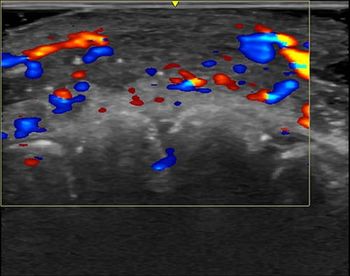
Fix Radiology Workflows with Business Analytics
CHICAGO-A case study of how the Hospital of the University of Pennsylvania is attempting to solve radiology’s challenges, as discussed at RSNA 2015.
To those that might be skeptical about the benefits of business analytics in radiology, Mindy Yang Licurse, MD, Hospital of the University of Pennsylvania, re-emphasized at RSNA 2015 the problems that radiology faces, which haven’t changed, or been solved, in over a decade.
Licurse referred to a 2004
Commoditization in radiology is still a threat to radiology 12 years later.
“Where are we in 2015? Are we thinking of ourselves as a commodity? Letting ourselves be a commodity?” she said.
Licurse went on to describe some applications of business analytics at the Hospital of the University of Pennsylvania, and how these solutions, and more generally, business analytics, can protect radiologists from commoditization and increase their value.
Follow-up Recommendations[[{"type":"media","view_mode":"media_crop","fid":"45008","attributes":{"alt":"","class":"media-image media-image-right","id":"media_crop_5342988680084","media_crop_h":"0","media_crop_image_style":"-1","media_crop_instance":"5078","media_crop_rotate":"0","media_crop_scale_h":"0","media_crop_scale_w":"0","media_crop_w":"0","media_crop_x":"0","media_crop_y":"0","style":"border-width: 0px; border-style: solid; margin: 1px; float: right;","title":"Mindy Yang Licurse, MD","typeof":"foaf:Image"}}]]
Failure to communicate important findings that may require follow up has been noted as a causative factor in 80% of medical malpractice lawsuits, Licurse said.
“If you look at our traditional workflow, let’s imagine first what took place: patient comes in, gets imaging for some reason, radiologists generate a report, it is at that point that we have a responsibility of calling the referring provider,” she said. “Then, the referring provider decides whether the patient is clinically indicated to go on for imaging and communicate with the patient, then of course the responsibility lies with the patient to go for the exam.”
There are several gaps in this workflow, Licurse said.
“Was the phone call placed? Did the patient hear about the results? Is the patient going to show up? Who is tracking these things?” she said
At the University of Pennsylvania, the solution to this problem was an Automated Radiology Recommendation Tracking Engine (ARRTE), implemented in July 2013. The 1.0 version of the system tracked follow-up recommendations in abdominal imaging across CT, MR, and ultrasound for the liver, pancreas, adrenal glands, and kidneys.
Radiologists had to start using a new coding system after the implementation of ARRTE, the lexicon was new but analogous to BI-RADS. For example, 0 and 3 would represent an indeterminate lesion, 1 would be no mass, 2 is a benign mass, and 4 through 7 ranges in degree of how suspicious one is for possible malignancy.
ARRTE mines the RIS system daily to determine whether relevant patients have been scheduled for follow-up or not. The system knows whether follow-up is required based on the radiologist’s code. If follow-up has not been scheduled or completed, the system will send escalating alerts to the referring physician, and provide feedback notifying the radiology department whether the communication had been received.
“[ARRTE allows us to see] whether or not a radiologist has coded within the report that there is a finding that needs to be noted,” Licurse said. “It will send automated responses and notifications to radiologists if they have missed a coding or, for example, if they put a finding in the report, but did not describe it in the impressions.”
Version 2.0, which was implemented July 2015, tracks recommendations beyond the four original organs and exams. It also added the ability to recommend nonimaging follow-up.
“I think this is quite monumental, it’s easy to get buried in the idea that imaging is the be-all, end-all, but we are really adding diagnostic value by suggesting the next step that needs to be taken,” Licurse said.
Actionable Reporting
The quality of radiology reports is an important concern for radiologists, Licurse said.
“What this means is, how confident are we really in the information we are supplying? Are we giving any more value?” she said. “Some people would argue that hedging is taking away from the value of the radiologists.”
With business analytics, you can do things like search for the phrasing “cannot exclude” and see across different providers who really uses that phrase the most.
“I think sometimes this can cause a lot of uneasiness for us to shift in our seats and think this is potentially going to be used punitively,” Licurse said. “I think we really need to change our mindset to see that this is about analyzing trends, defining gaps, and how we can grow with this as opposed to get punished by it.”
ARRTE is also used to look at uncertainty in terms of how often 0s and 3s are used. Licurse acknowledged that certain times 0s and 3s are necessary, but ARRTE can help identify if perhaps there are areas that are being coded this way without true validation.
Error Detection
While straightforward in nature, error detection can play a big part in patient perception of radiologists, Licurse said.
“One of the easiest ways to help ourselves is to make sure we don’t make errors,” she said. “When it comes to things like gender, laterality, there are a lot of implications here beyond just patient perception, but also patient safety.”
The system can identify if a patient was marked as female, but the report included male anatomy. Laterality error detection can now be increasingly monitored by different real-time mechanisms, Licurse said.
“I think that some of the tools we have are very unique in our ability to improve our connection with our colleagues and patients,” Licurse said. The future of business analytics can help identify targeted imaging driven by clinical decision support, real time analytics, and choosing the right key performance indicators in patient-centric analytics/outcomes, she said.
Newsletter
Stay at the forefront of radiology with the Diagnostic Imaging newsletter, delivering the latest news, clinical insights, and imaging advancements for today’s radiologists.




























